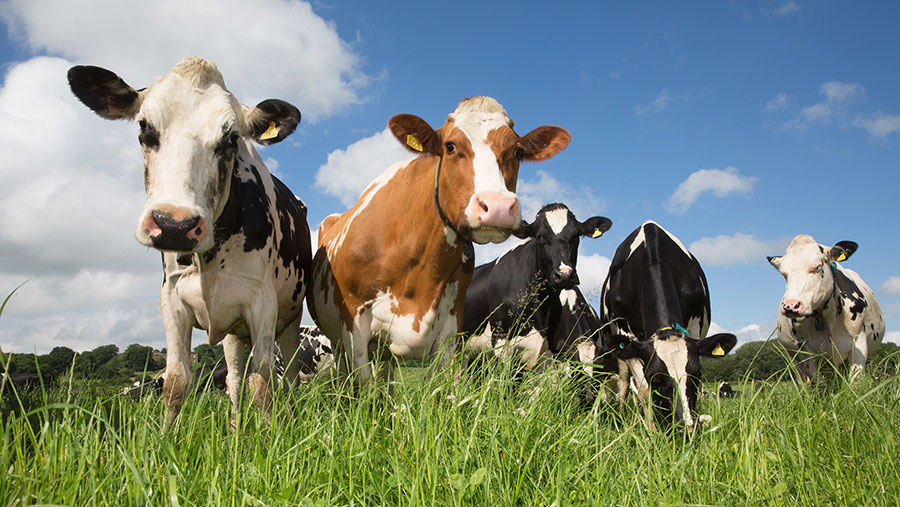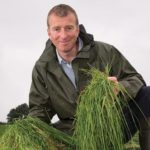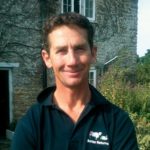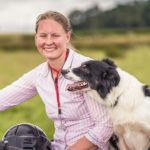Grass Watch: Growth rates plummet as drought bites
 © Tim Scrivener
© Tim Scrivener After almost a month a no rain, all six of our Grass Watch columnists have been dealing with poor grass growth rates.
Combined with low nightly temperatures, this has seen grass growth dip to as low as 25kg DM/day on our most northern farm.
This has meant regularly measuring covers to get an idea of deficits and planning ahead to meet feed demand has been vital for everyone.
Robert Craig
- Land Total 210ha
- Stock 430 New Zealand/Kiwi-cross cows
- Altitude Ranges from 160-210m above sea level
- Calving Spring calving

Robert Craig © John Eveson
With no rain to speak of for the past four weeks, there is just a hint of irony this morning as the drops are starting to run down the office window.
Following an unusually dry April, both farms are now beginning to suffer from lack of moisture. Two weeks of cold easterly wind (Helm) has slowed growth to about half of what we expect in late April or early May.
However, both herds continue to produce to expectation at just over 2.1 kg MS/day – although with an eye on covers and cow condition, we are feeding hard to achieve this.
With calving all but over and mating now in full swing, we should be on or near our peak milk and grass production and should be looking to make some silage soon.
While this looks a long way off today, things can and do change rapidly – this is Cumbria, after all.
|
Stocking rate on grazing platform (cows a ha) |
4.05 |
|
Growth rate on platform (kg DM/day) |
55 |
|
Average farm cover (kg DM/ha) |
2185 |
|
Yield (litres a cow a day) |
27 |
|
Fat (%) |
4.29 |
|
Protein % |
3.61 |
|
Milk solids (kg a cow) |
2.1 |
|
Supplements fed (kg a cow a day) |
5 |
|
Average rainfall (mm) |
36 (April) 0 (May) |
|
Land type |
Free-draining sandy loam |
|
Figures correct up to 12 May |
|
Mike Miller
- Land: 106ha
- Stock 420 NZ Suffolk-cross Mules and 100 NZ Romney ewes
- Altitude 100m above sea level

Mike Miller
Dr Christine Jones, the Australian soil expert, perhaps put into perspective our concerns of potential “drought”. At a recent soils event, we walked through lush green crops, which in her eyes could never resemble drought-like conditions.
Growth rates have certainly been pegged back by temperature and low rainfall, meaning grass demand has still just topped supply, but recent rains will no doubt reverse this, I hope.
Fields shut up for silage are bulking up well now and are close to cutting.
The main crop of swedes has been slow to appear, but now a good number of cotyledons are showing. Likewise, the spring ryegrass/clover reseeds will welcome a break in the weather.
|
Cows or ewes a hectare |
1.1 livestock unit |
|
Growth rate (kg DM/ha)
|
43 |
|
Average farm cover (kg DM/ha) |
2,258 |
|
Land type |
Heavy clay |
|
Rainfall (mm) |
31 |
|
Figures correct up to 15 May |
|
Ben Richards
- Land 146ha
- Stock 280 Jersey-cross Friesians
- Altitude 110m above sea level
- Calving Spring-calving

Ben Richards
Four weeks with no rain in the spring has certainly kept the grass in check, with growth lower than 60kg DM//ha/day.
I have been finding it a bit tight and have only just been keeping up with herd demand.
Now the grass is responding to the first shower (two weeks ago), the dry matter has dropped to 55. In order to fully feed the herd after the rain, I need to speed up the round or put feed in.
I am already on a 16-day round and have no supplements left on farm. I did, however, have 10 bags of urea, which have duly been spread.
I am confident of getting 90+kg DM/ha of growth this week and should see a sustained period of high growth rates.
The whole farm has been slit aerated recently, so the rain will last us a good eight weeks (wet farms are good sometimes). I have a lot of seedlings popping up. I just hope they are herbs and not weeds.
|
Stocking rate on grazing platform (cows a ha) |
3.2 |
|
Growth rate on platform (kg DMM/day) |
71 |
|
Average farm cover (kg DM/ha) |
2,108 |
|
Yield (litres a cow a day) |
19 |
|
Fat (%) |
4.7 |
|
Protein (%) |
3.8 |
|
Milk solids (kg a cow) |
1.61 |
|
Supplements fed (kg/cow/day) |
0 |
|
Average rainfall (mm/day) |
52 |
|
Land type |
Free-draining sandy loam |
|
Figures correct up to 15 May |
|
Richard Fryer
- Land 97ha
- Stock 230 Friesian cows plus 120 youngstock
- Altitude 40m
- Calving Autumn block calving. Mainly grass based

Richard Fryer
A month of cool, dry conditions has meant excellent grazing conditions in the field, with good grass use and no poaching.
However, growth has only just kept up with demand or even been slightly lower at times, meaning 2kg DM of silage a cow was fed in the last two weeks of April to push out the round length to 30 days.
Now it has rained I am expecting growth to rocket, so frequent monitoring and decision-making will be crucial to keep on top of the grass and maintain a quality sward.
As we approach June, grass will be trying to produce a seed head, so we will be entering covers at 2,800kg DM/ha to ensure we keep hitting a good residual figure of 1,500-1,600kg DM/ha.
Some 40ha of first-cut was taken in the first week of May. This ground has now had slurry and fertiliser and is growing back well. We aim to cut this ground four or five times over the season.
@rjfryer76
|
Stocking rate on grazing platform (cows/ha) |
4.6 |
|
Growth rate on platform (kg DM/day) |
56 |
|
Average farm cover (kg DM/ha) |
2,353 |
|
Yield (litres a cow a day) |
18 |
|
Fat (%) |
4.25 |
|
Protein (%) |
3.75 |
|
Milk solids (kg a cow) |
1.44 |
|
Supplements fed (kg a cow a day) |
1 |
|
Average rainfall (mm/day) |
30 (16/5/17) |
|
Land type |
Medium |
|
Figures correct as of 16 May |
|
Alice Muir, Buccleuch Estates
- Land Langholm Farms: 7,085ha, mainly heather hill with 400ha of permanent grassland; 80m-404m
- Stock: 1,560 Blackface Ewes, 1,100 Scottish Country Cheviot ewes, 900 Greyface/Aberfield ewes and 50 Galloway Cows
- Altitude 80-404m

Alice Muir
We have finished lambing now and are starting to drench for nemotodirus and vaccinate for clostridial diseases.
At this point, we are also looking to give the lambs an injection to aid mineral status. This means lambs are now being grouped together into bigger bunches, ready to start the rotation.
A target date for the rotation is 20 May. Normally I would like to have started rotating them by now, but the severe lack of rain and a colder period has meant our residuals are lower than normal and nemotodirus hasn’t been a risk factor yet. At least the outdoor lambing has benefited.
We have also removed the ewes from the red clover field and hopefully it will start to freshen up for silage. Current dry matter is about 1,800kg/ha.
Our neighbours are busy cutting silage and are aiming for light, high-quality cuts for dairy cows. However, even they appear to have lower covers than normal.
We are just about to start work on a grassland trial involving herbal leys under rotation versus high-producing ryegrasses.
We have taken soil samples, corrected the pH and have started to look at mixes that suit our wet/heavy ground in order to maximise gain/growth.
Hopefully the trial will provide further guidance about what suits our soils and rotational system best.
|
Cows or ewes a hectare |
7 |
|
Growth rate (kg DM/ha) |
25 |
|
Average farm cover (kg DM/ha) |
1,650 |
|
Land type |
Peat/clay |
|
Rainfall (mm) |
5 |
|
Figures for month ending 11 May |
|
Sam Chesney
- Stock 150 Limousin sucklers
- Altitude 30m above sea level

Sam Chesney © Steffan Hill
Grass growth has really slowed, with last week only showing 36.3kg DM/ha.
However, my demand was 71.4kg, showing a deficit, and silage was fed to a couple of groups to slow the rotation. Covers are 2,163kg DM/ha on the grazing platform, yet we are carrying a stocking rate of 3,177kg/ha and are nine days ahead.
Rain to date shows 15.4mm – 12mm of which came last night (15 May). This moisture was badly needed and we have sown new grass on the promise of moisture.
Silage needed rain, so I have missed the heatwave in favour of some bulk, as it is still early and our swards were grazed first.
Last month’s thistles have been sprayed and has achieved a good hit without killing my clover, thanks to advice from my Facebook friends.
|
Cows or ewes a hectare |
2,541kg liveweight |
|
Growth rate (kg DM/ha) |
36.3 |
|
Average farm cover (kg DM/ha) |
2,163 |
|
Land type |
Medium/heavy |
|
Rainfall (mm) |
15.4 |
|
Figures for month ending 15 May |
|
Gareth Davies – independent grassland expert
The story of the past month across the country has been one of a significant drop in grass growth. I was measuring fields in the first week of May that were only growing 35kg DM/day, which is way below expectations.
However, with the badly needed rain arriving this week, those fields are now growing more than 70kg DM/day.
This highlights why it is so important to keep a very close eye on your grass growth, because you need to react as quickly as your grass does. The main reason for this very slow early-season growth has been twofold.
First, the night-time temperatures have been very low (on 12 May I was scraping my windscreen), which means it takes the soil a long time to get up to growing temperature and subsequently leaves a very short growing day. Second, the bigger reason has been the complete lack of moisture.
I have heard a lot of people saying there is nothing they can do about the lack of rain, which is obviously a fact, but people don’t always realise they can influence the water-holding capacity of their soil by increasing organic matter, which by default influences the soil organic carbon content.
This is key to the soil’s moisture-retaining abilities. A second way of helping the situation is dealing with compaction, because if the rain lands on the ground and cannot infiltrate the soil, it will simply run off the surface.
We cannot dictate the weather, but we can make sure our soil is in the best possible health to be able to make the most of what it is dealt.
